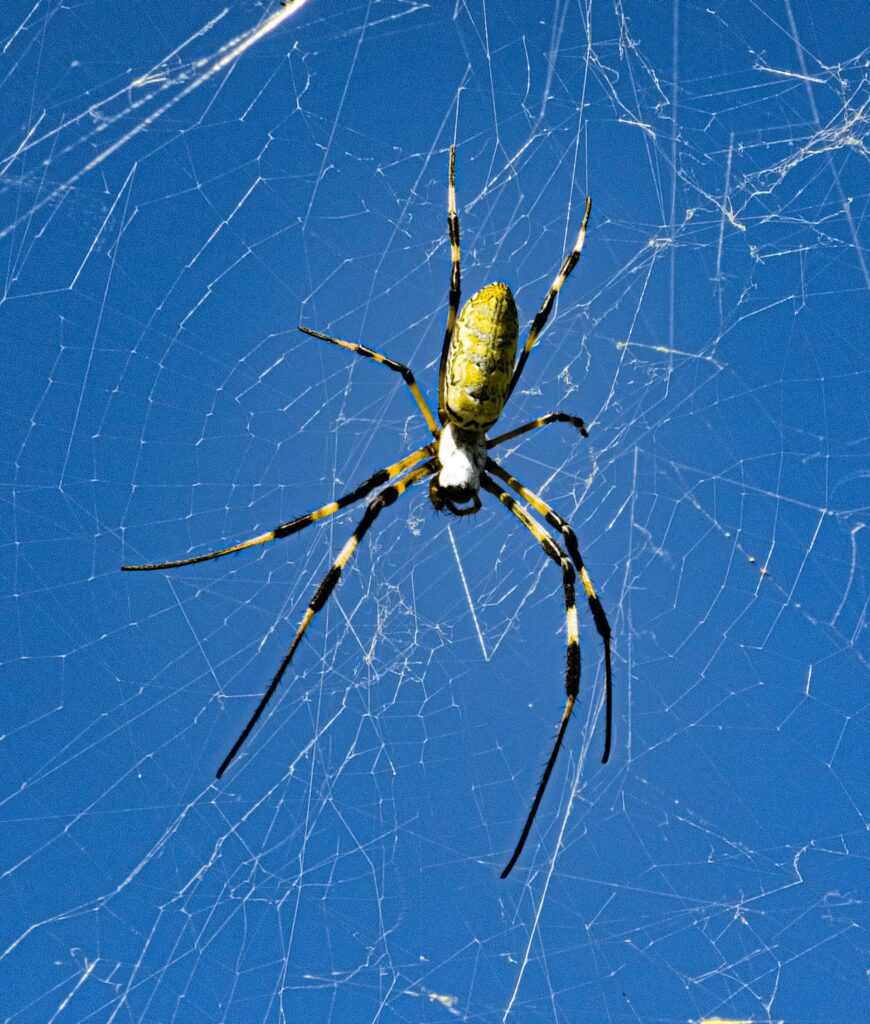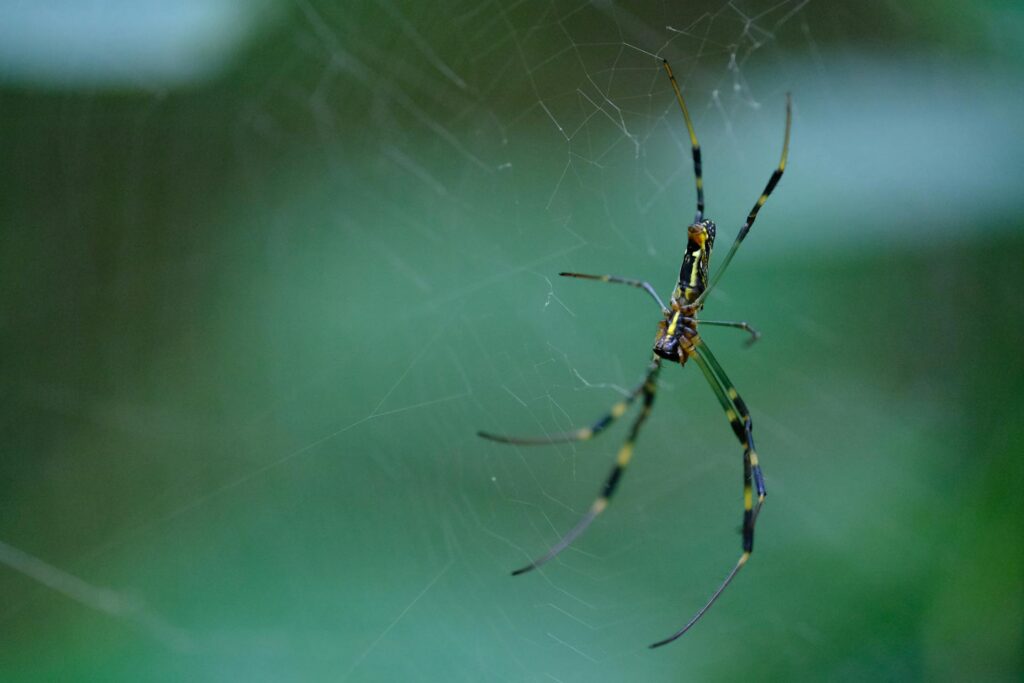What You Need to Know About Joro Spiders

Are you concerned about the latest pest invasion in the United States?
The Northeast is bracing for an influx of giant venomous spiders—but it’s not as bad as the headlines make out.
Big and brightly colored, Joro spiders may be a little intimidating. The good news is they don’t pose a threat to human or pet health.
This article will unpack any concerns related to these invasive arachnids. We’ll explain how to identify them, what the risks are, and how you can keep them away from your home.
What Are Joro Spiders?
Joro spiders, known scientifically as Trichonephila clavata, are an invasive species native to areas of East Asia, including Japan, Korea, Taiwan, and China. They are part of the orb-weaver group, which means they build webs that roughly resemble wheels.
These spiders were first observed in the US in 2013 in Georgia. Scientists believe they arrived via international cargo, possibly by hitching a ride on shipping containers.
Joro spiders have a very distinctive appearance. Adult females have bright black-and-yellow coloration. They also spin large, golden-hued webs that can span up to 10 feet. They’re not hard to miss! Despite their large size and striking colors, Joro spiders are shy and docile. When threatened, they tend to freeze and can remain motionless for over an hour.
In terms of diet, Joro spiders mostly feed on insects that get trapped in their webs. This can sometimes lead to competition with native spiders for food.
One reason for their successful spread is their adaptability. Joro spiders thrive in busy urban and suburban environments where there’s plenty of access to food and shelter.
Finally, there’s a lot of talk about the Joro spider’s ability to fly. This is a myth—well, for the most part. Fully grown Joro spiders can’t fly at all. Their young ones, on the other hand, can.
Spiderlings use a method called “ballooning” to travel incredibly long distances. They shoot silk threads out, which catch the wind like a sail. This lifts the spider up and causes them to float through the air. It’s one way they spread to new areas.
How to Identify Joro Spiders
Think you might have a Joro spider in your home or garden? Here’s how to find out.
First, look at the size of the spider. Female Joro spiders are typically the larger of the two sexes. They can have a leg span of three to four inches—this is about the size of your hand. The body length of females ranges from 0.66 to 0.98 inches. In contrast, males are much smaller, with a body length of 0.27 to 0.39 inches and a less impressive leg span.
Next, check the color. Female Joro spiders have bright yellow and black coloring with blue bands on their legs. On their abdomen, you’ll see a unique blend of red, yellow, and black shapes in asymmetrical patterns. Male Joro spiders, in contrast, are plainer. They generally have a straightforward brown coloring.
Then, think about the time of year. Joro spiders are most commonly spotted during the fall months of September and October. This is when the spiders reach their maturity and get ready to lay eggs. During this time, you might see their large, golden webs stretching between trees, bushes, and man-made objects like buildings and signposts.
Take a good look at the web. As we mentioned, the Joro spider’s web is large and wheel-shaped. The silk has a slight golden color to it when it catches the sunlight in just the right way.
Are Joro Spiders Spreading?
Yes, Joro spiders are spreading across the country. Their population is currently concentrated in the Southeast around Atlanta. However, people in Oklahoma, West Virginia, and Maryland have reported seeing these invasive spiders in their communities.
Joro Watch is an excellent website where people can share their sightings and help scientists track the spread of this species.
What Are the Risks of Joro Spiders?

Joro spiders are resilient and adaptable, with an impressive ability to make themselves at home in a range of environments. Despite this, their spread across the country is not as alarming as some news stories might have you think.
These arachnids very rarely bite humans. Even if they do, the bite itself is less painful than a bee sting. The venom is perfectly formulated to subdue small insect prey. This means it’s not dangerous to humans—let alone deadly. In fact, in most cases, medical treatment is not required.
While Joro spiders aren’t a threat to human health, they are still considered an invasive species. Invasive species compete with native plants, animals, and insects for food and resources, which can disrupt the balance of local ecosystems and biodiversity. What’s more, changes in the population of established spider species can have a far-reaching ripple effect, influencing the populations of other insects and animals.
What You Can Do to Keep Joro Spiders Away from Your Home
Joro spiders may not be dangerous, but that doesn’t mean you want them hanging around your property. Below are some practical steps you can take to discourage spiders of all species from taking up residence in your home.
Eliminate Food Sources
Spiders are predators that feed on other insects. To keep Joro spiders away, you need to eliminate their food sources. Here are some ways to do this:
- Spiders feed on insects like flies, mosquitoes, ants, beetles, and moths. Use insect repellents and traps to reduce the number of these insects in and around your home.
- Don’t leave food out, as it can attract insects, which, in turn, attract spiders. Store food in sealed containers and keep your kitchen clean to prevent insect infestations.
- Ensure your garbage bins are tightly sealed. Regularly dispose of garbage so it doesn’t draw insects into your home.
Tidy Your Yard
In addition to food, spiders need some shelter from the elements. A tidy yard can discourage spiders from building webs.
- Keep your yard clean and free of debris. Remove leaves, grass clippings, and other yard waste that can attract insects and provide shelter.
- Trim plants, shrubs, and trees so they stay away from the walls of your home. When plants become overgrown, they create hiding spots for spiders and their prey.
- If you feel comfortable, you might remove spider webs from your garden. This sends a clear message that they’re not welcome. Proceed with caution, however, as not all spiders are as harmless as the Joro.
Seal Up Entry Points
You don’t want spiders in your home. To many, they’re creepy and, in some cases, can be dangerous. One of the best ways to keep them outside where they belong is to make it difficult to enter. Here’s how:
- Make a habit of inspecting your home’s exterior for cracks and gaps. Even small openings are enough for spiders and other pests to enter. Pay particular attention to the spaces around windows and doors. If you spot a gap, use a weather-resistant caulk to seal it up.
- Check the screens covering your windows and vents. Are there any holes or tears? If so, repair them or replace the screen.
- Finally, install weather stripping around doors and windows to cover gaps.
Keep Your Home Clean
A clean home is less attractive to spiders and their prey. Here are some chores to add to your cleaning schedule:
- Vacuum your home regularly, paying particular attention to corners, under furniture, and other hard-to-reach places. This helps remove spiders, food, webs, and insects.
- Clutter creates hiding spots for spiders. Keep your home as organized as possible, including in basements, attics, and garages.
- Store items in sturdy containers with tight-fitting lids instead of cardboard boxes.
Invest in Pest Control
Tried it all without luck? Want to prevent infestations?
Now’s the time to consider professional pest control services.
- Schedule regular pest control inspections to identify and address potential infestations early.
- Pest control professionals can apply treatments to help eliminate both spiders and the insects they feed on.
- Always follow the recommendations provided by pest control professionals to keep spiders out of your home.
Protect Your Home from Joro Spiders
Joro spiders are all over the news—and for good reason. They’re invasive, large, and brightly colored, so they stand out. That being said, if you’ve spotted a Joro spider in or around your home, you’re probably okay. These spiders are relatively harmless.
However, if you do want to keep Joro spiders and other pests away from your property, follow the steps outlined above. A little proactive preparation can help you keep your home free from creepy crawlies all year around. Finally, if you would like help with spider control, reach out today or request a quote. Our pest control experts are more than happy to discuss your pest control options.








